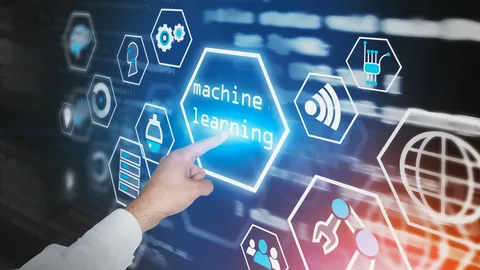Artificial Intelligence (AI) and Machine Learning (ML) are revolutionizing the way we handle data, transforming it into actionable insights that drive innovative solutions. These technologies enable us to analyze vast amounts of data with unprecedented accuracy and speed, uncovering patterns and trends that would be impossible to detect manually. AI and Machine Learning are not
Artificial Intelligence (AI) and Machine Learning (ML) are revolutionizing the way we handle data, transforming it into actionable insights that drive innovative solutions. These technologies enable us to analyze vast amounts of data with unprecedented accuracy and speed, uncovering patterns and trends that would be impossible to detect manually. AI and Machine Learning are not just about automating processes; they are about enhancing our ability to make data-driven decisions, thereby opening new avenues for innovation across various industries.
Historical Development of AI and Machine Learning

Image by : Yandex
The historical development of AI and Machine Learning in data analytics has been a journey of continuous evolution. From the early days of simple rule-based systems to the sophisticated neural networks of today, AI and Machine Learning have made significant strides. Initially, the focus was on creating systems that could perform specific tasks, but over time, the emphasis shifted to developing algorithms that could learn from data and improve over time. This evolution has been particularly impactful in data-driven decision-making, where AI and Machine Learning have transformed how organizations leverage data to gain insights and make informed decisions.
Core Concepts in AI and Machine Learning
Understanding the core concepts in AI and Machine Learning is crucial for appreciating how these technologies power data solutions. At their heart, AI involves creating machines that can perform tasks that typically require human intelligence, such as reasoning, learning, and problem-solving. Machine Learning, a subset of AI, focuses on developing algorithms that allow computers to learn from and make predictions based on data. These core concepts are the foundation upon which AI and Machine Learning build powerful data solutions, enabling us to analyze and interpret complex datasets with remarkable precision.
Applications of AI in Data Solutions
AI and Machine Learning significantly enhance the accuracy of data analytics. By applying sophisticated algorithms to large datasets, these technologies can identify patterns and trends that might be missed by traditional methods. This enhanced accuracy is crucial for making data-driven decisions, as it ensures that insights are based on reliable and comprehensive data analysis. Machine Learning algorithms, in particular, are adept at optimizing decision-making processes by continuously learning from new data and refining their predictions. This capability is invaluable for organizations looking to stay ahead in a data-driven world.
Machine Learning Techniques for Data Analysis
Several Machine Learning techniques are pivotal for data analysis. Supervised learning, for instance, is widely used for predictive data analysis. In this approach, the algorithm is trained on a labeled dataset, learning to predict outcomes based on input data. This technique is particularly useful for tasks such as forecasting sales or predicting customer behavior. On the other hand, unsupervised learning is employed to identify patterns in data without predefined labels. This method is essential for discovering hidden structures within datasets, such as customer segmentation or anomaly detection, providing deeper insights into complex data.
Role of Big Data in AI and Machine Learning
Big Data plays a crucial role in fueling the capabilities of AI and Machine Learning. The vast amounts of data generated daily provide the raw material that these technologies need to learn and make predictions. AI and Machine Learning algorithms thrive on Big Data, using it to extract valuable insights and drive decision-making processes. The ability to analyze large datasets allows these technologies to uncover patterns and trends that were previously hidden, enabling more accurate and comprehensive data analysis. In essence, Big Data is the lifeblood of AI and Machine Learning, powering their ability to transform data into actionable insights.
Challenges in Implementing AI and Machine Learning
Despite their potential, implementing AI and Machine Learning comes with its own set of challenges. One significant issue is data quality. For AI and Machine Learning algorithms to be effective, they require high-quality, accurate data. Inaccurate or incomplete data can lead to erroneous insights and poor decision-making. Scalability is another challenge, as AI and Machine Learning solutions need to handle increasing amounts of data efficiently. Ensuring that these technologies can scale to meet growing data demands without compromising performance is a critical aspect of their implementation.
Future Trends in AI and Machine Learning

Image by : Yandex
Looking ahead, AI and Machine Learning are poised to enhance predictive analytics capabilities significantly. As these technologies continue to evolve, they will become even more adept at forecasting future trends and behaviors based on historical data. This will enable organizations to make more proactive and informed decisions. Additionally, AI and Machine Learning are set to automate complex data processing tasks, reducing the need for human intervention and increasing efficiency. These future trends promise to further revolutionize data-driven decision-making, offering unprecedented opportunities for innovation.
Ethical Considerations in AI and Machine Learning
As we continue to integrate AI and Machine Learning into various aspects of our lives, ethical considerations become increasingly important. One major concern is bias in AI and Machine Learning algorithms. If the data used to train these algorithms is biased, the resulting insights and decisions will also be biased, potentially leading to unfair or discriminatory outcomes. Transparency in AI and Machine Learning decision-making processes is another critical issue. It is essential for organizations to ensure that their AI systems are transparent and that the decision-making processes are understandable and explainable to users.
Conclusion and Future Prospects
In conclusion, AI and Machine Learning are revolutionizing data-driven decision-making, offering innovative solutions that transform how we analyze and interpret data. These technologies have come a long way, and their future prospects are incredibly promising. As AI and Machine Learning continue to evolve, we can expect even more sophisticated data solutions, enabling us to make more accurate and informed decisions. The future of AI and Machine Learning holds the potential for unprecedented innovations, driving us towards a new era of data-driven insights and solutions.
















